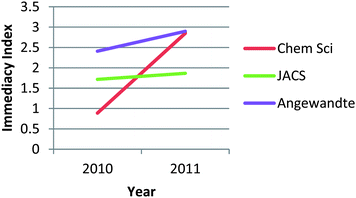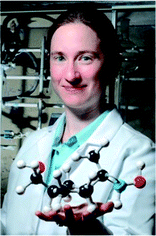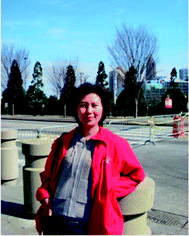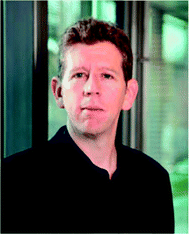Chemical Science Editorial
Abstract
2012 has been another very successful year for Chemical Science. Increasing submissions, new Associate Editors and an impressive first partial impact factor are just a few of the highlights discussed in the latest Editorial.
Quality
From the day the journal was announced in August 2009, the quality of Chemical Science is something that we have always been passionate about. In 2012, this remained the key focus for both the Editorial Office and the Associate Editors, so as submissions have continued to grow, so has the rejection rate. The outcome of implementing such high standards is that around 60–70% of articles are rejected without review and, overall, the rejection rate is around 85%. We are committed to this approach to ensure we safeguard the quality of the journal with only the top articles being published.To give you a flavour of the quality and breadth of Edge articles published in 2012; Table 1 showcases some of the most read.
| Title and authors | DOI | Citation |
|---|---|---|
| Concise total synthesis of (+)-gliocladins B and C, Mohammad Movassaghi et. al. | 10.1039/C2SC20270K | Chem. Sci., 2012, 3, 1798–1803 |
| Copper-catalyzed decarboxylative C–N coupling for N-arylation, Sejal Patel and Nello Mainolfi et. al. | 10.1039/C2SC20606D | Chem. Sci., 2012, 3, 3196–3199 |
| Long-lived long-distance photochemically induced spin-polarized charge separation in β,β′-pyrrolic fused ferrocene–porphyrin–fullerene systems, Jeffrey R. Reimers, Shunichi Fukuzumi and Maxwell J. Crossley et. al. | 10.1039/C1SC00614B | Chem. Sci., 2012, 3, 257–269 |
| Low band gap selenophene–diketopyrrolopyrrole polymers exhibiting high and balanced ambipolar performance in bottom-gate transistors, Martin Heeney et. al. | 10.1039/C1SC00477H | Chem. Sci., 2012, 3, 181–185 |
| Postsynthetic ligand exchange as a route to functionalization of ‘inert’ metal–organic frameworks, Kimberly A. Prather and Seth M. Cohen et. al. | 10.1039/C1SC00394A | Chem. Sci., 2012, 3, 126–130 |
| A solvent-responsive coordination cage, Kay Severin et. al. | 10.1039/C1SC00779C | Chem. Sci., 2012, 3, 701–704 |
| Photocatalytic oxidation of water by polymeric carbon nitride nanohybrids made of sustainable elements, Xinchen Wang et. al. | 10.1039/C1SC00644D | Chem. Sci., 2012, 3, 443–446 |
| Dynamic potential–pH diagrams application to electrocatalysts for water oxidation, Allen J. Bard et. al. | 10.1039/C1SC00516B | Chem. Sci., 2012, 3, 217–229 |
| Visible-light-mediated photochemistry: accelerating Ru(bpy)32+-catalyzed reactions in continuous flow, Peter H. Seeberger et. al. | 10.1039/C2SC01016J | Chem. Sci., 2012, 3, 1612–1616 |
| One hundred fold overall sensitivity enhancements for Silicon-29 NMR spectroscopy of surfaces by dynamic nuclear polarization with CPMG acquisition, Lyndon Emsley et. al. | 10.1039/C1SC00550B | Chem. Sci., 2012, 3, 108–115 |
As outlined in previous Editorials we are committed to publishing high quality research from across the whole of the chemical sciences with the overriding objective of being the only truly general chemistry journal.
Impact
In 2012, Chemical Science received its first impact factor of 7.57 (2011 Journal Citation Reports®, Thomson Reuters 2012). This is only a partial value based on one year's citations to articles published in 2010 however we were delighted to see the journal being read and cited so widely already. The immediacy index, a measure of how topical and urgent a research article is, also grew significantly (Fig. 1), putting Chemical Science alongside its major rivals after just three years. | ||
| Fig. 1 Immediacy index values for the leading general chemistry journals (Thomson Reuters 2012). | ||
We are confident that such an increase in immediacy index will lead to a further rise in impact factor when the 2012 Journal Citation Report® is published in the summer of 2013.
Associate Editors
The Associate Editors continue to be a key asset for the journal and we would like to thank them for their hard work and dedication over the last year. In 2012, there were a few changes to note with Professors Matthew Rosseinsky, Benjamin Cravatt and Thomas Carell all retiring, and three outstanding researchers appointed as replacements with a fourth in discussions at the time of this Editorial going to press.In June, we were delighted to announce the appointment of Professor Melanie Sanford, University of Michigan, who is handling papers predominantly in, but not limited to, the field of physical organic chemistry. This appointment was followed in August by Professor Tom Muir, who is handling articles in the field of chemical biology. The final addition of the year came in September with Professor Jihong Yu, Jilin University, who has expertise in inorganic materials. These new Associate Editors are, as with previous appointments, leaders in their respective fields and ideally placed to implement the standards required to make Chemical Science a leading journal.
Publications
Submissions to Chemical Science have continued to grow throughout 2012 and we expect this trend to continue in 2013. On average, submissions to the journal are now double the number we received prior to the release of the impact factor in late June. Geographically, we are delighted with the balance of submissions from almost 50 countries showing that the profile of the journal is continuing to grow. Fig. 2 shows the top 10 countries with the largest percentage of publications in 2012. | ||
| Fig. 2 Top 10 publishing countries in Chemical Science in 2012 (data correct as of November 13, Web of Knowledge, Thomson Reuters). | ||
We are delighted with the continued strong support from both the USA and UK over the last 12 months. Also pleasing are the numbers of articles published from German and Japanese researchers as well as the growth in publications from China.
International Symposium on Advancing the Chemical Sciences and the Chemical Science symposium
The International Symposium on Advancing the Chemical Sciences (ISACS) continued in 2012, with Challenges in: Organic Chemistry and Chemical Biology—ISACS 7 (Edinburgh), Inorganic Chemistry and Materials Chemistry—ISACS 8 (Toronto) and Nanoscience—ISACS 9 (Xiamen). 2012 also brought record numbers of delegates with ISACS 7 oversubscribed. A clear indication that the ISACS brand is becoming well established in the chemical science community.The 2013 symposia are well underway with confirmed speakers and venues all in place. The topics, venues and chairs for the 2013 ISACS symposia are given in Table 2.
| Topic | Chair(s) | Venue | Date |
|---|---|---|---|
| Challenges in Supramolecular Chemistry and Organic Materials | Professor Susumu Kitagawa | Kyoto, Japan | 18–20 June |
| Challenges in Chemical Biology | Professor Ben Davis | MIT, Boston, USA | 23–26 July |
| Challenges in Chemical Renewable Energy | Dr Erwin Reisner and Professor James Durrant | Cambridge, UK | 3–6 September |
For further details on the forthcoming ISACS meeting please visit the website or sign up to Twitter alerts (http://www.twitter.com/ISACSconference)
We are also pleased to announce that prior to ISACS 10 in Kyoto, Japan, Professor Feihe Huang will be hosting a Chemical Science Symposium in Zhejiang University, Hangzhou, China. The event is scheduled to take place over the weekend of 15–16 June, with 8 international and 8 local speakers presenting over the two days. Confirmed international speakers include Professors Makoto Fujita (Tokyo, Japan), Philip Gale (Southampton, UK), David Smith (York, UK), Lee Cronin (Glasgow, UK), Thorri Gunnlaugsson (Trinity College, Dublin), Alberto Credi (Bologna, Italy) and Vivian Yam (Hong Kong). For further details on this free event check the Chemical Science blog.
Read all about it…
You can keep up-to-date with all the latest news from Chemical Science in a variety of ways. Follow us on Twitter (http://www.twitter.com/chemicalscience) where we now have an online community of around 3000 followers, or on Facebook (http://www.facebook.com/chemical.science.journal) where, after only five months, we have almost 800 ‘likes’. Alternatively, the Chemical Science blog (http://blogs.rsc.org/sc) is updated with the latest news. Don't forget if you have any ideas for reviews or feedback in general we would like to hear from you (E-mail: chemicalscience-rsc@rsc.org).And finally…
As is customary at this time, it is important we acknowledge all the people who have been involved with Chemical Science over the last 3 years. In particular, we would like to thank all our authors, referees, Associate Editors and the Cambridge Editorial team for their dedication and support. We hope you will continue to work with us in 2013, as with your help, we can achieve our key objective of becoming the number one ranked journal for the chemical sciences.Professor David MacMillan, Editor-in-Chief, Dr Robert Eagling, Managing Editor, Jane Hordern, Deputy Editor and Philippa Ross, Senior Publishing Editor
| This journal is © The Royal Society of Chemistry 2013 |



